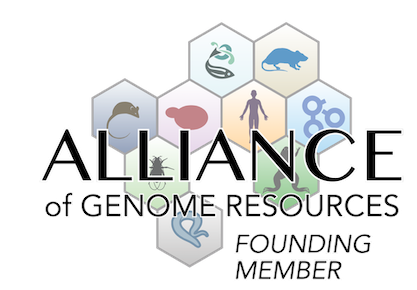Inbred Strains
of Rats: SS
Inbr. F42.
Colour: Albino,
Genet. c.
Origin: Rapp from a colony of Sprague-Dawley outbred rats developed by
LK Dahl, Brookhaven National Laboratories, Upton, New York, selected for
sensitivity to salt-induced hypertension (Dahl
et al 1962a,b, Rapp 1982). Also designated S/JR by Rapp (1984),
who gives an extensive review of the characteristics of the strain, and
Dahl S by Mollegard, Copenhagen. Note that the Dahl selected strain has
been independently inbred at the NIH, and designated DSS/N. There is likely
to be confusion among these colonies unless considerable care is taken
with nomenclature.
Stlezin et al (1992) found that SS and SR had about 80% of DNA fingerprint
bands in common, compared with 50% between SHR and WKY. According to Ginn
et al, (1993) analysis of RFLPs and microsatellites
suggest that SR is a reasonably good control strain for SS, though crosses
between SS and unrelated normotensive strains will be useful in dientifying
the loci responsibe for salt-induced hypertension.
Characteristics:
Produce one litter of about 8 pups, but second litter is small due to hypertension.
Develop fulminant hypertension and marked vascular and renal lesions after
3-4 weeks on a high salt (8% NaCl) diet, and all die within eight weeks
(Rapp and Dene, 1985), though on a low (0.3%
NaCl) salt diet they survive well though they also develop marked hypertension,
but with a slower rise in blood pressure. Blood pressure is also increased
by dietary potassium (Rapp 1984). Kidney transplantation
experients between SS and SR suggest that part of the sensitivity is due
to the kidney, and SS rats have 15% fewer glomeruli than SR rats (Rapp
1984). There was no evidence of genetic effects on blood pressure
operating through the early maternal intrauterine or foster environments
(Dene and Rapp 1985).
There is a defect of atrial natriuretic factor, possibly involving hyporesponsive
kidneys and decreased release of atrial natriuretic factor from atria
(Snajdar and Rapp 1985). Have a lower
blood pressure on a low salt diet (0.3%) than SHR, but a high (8%) salt
diet increased systolic pressure significantly more than in strain SHR
(Adams and Blizard, 1991).
Blood pressure defect may depend on a defective dopamine DA1
receptor, though the ability to excrete an acute saline load is not impaired
suggesting that other systems involved in sodium homeostasis compensate
for the defect in this strain (Hansell, 1995). Levels of IgG but not IgM
or IgA are decreased in young pre-hypertensive rats compared with SR,
and renal dysfunction is manifested by increased excretion of high molecular
weight proteins including albumin and immunoglobulins (Cowen et al, 1991). The mesenteric vasculature of rats
on a high salt diet is supersensitive to nerve stimulation and to norepinephrine.
This may be explained by hyperernoradrenergic innervation, elevated neuropeptide
Y innervation or altered release of transmitter (Kong el al, 1991).
Naloxone produces a slight attenuation of hypertension, but this may be
secondary to suppression of food intake and hence of salt (Johnson and richmond, 1992). F1 hybrids between SS and
SHR raised by SHR feamles weighed less at 35 days and after exposure to
a high salt diet developed high blood pressure more rapidly than those
reared by SS mothers (Blizard and Adams,
1992). The maternal environment is considered to be an important determinant
of blood pressure in crosses involving SS, SHR and WKY (McCarthy et al,
1992). Diminished myogenic responsiveness of afferent arterioles and interlobular
arteries contributes to impared renal autoregulation (Takenaka et al, 1992).
A high sucrose (52%) diet also leads to elevation of blood pressure, which
is more rapid in SS than in SR or F344 (Preuss
et al, 1992). Treatment with the novel anti-hypertensive drug cicletanine
reduced blood pressure in SS rats fed a high salt diet, and ameliorated
functional and morphological injury to the kidney. This correlated with
attenuation of lipid peroxidation in kidney homogenate, indicating that
cicletanine is an antioxidant that protects SS rats from hypertension
(Uehara et al, 1993a). Indapamide is
another antioxidant that has protective effects (Uehara
et al, 1993b). Increased arteriolar tone may be due to a localised
hyperresponsiveness to tissue metabolites (Rafi
and Boegehold, 1993). Long-term L-argenine administration prevents
hypertension and normalises the pressure-natriuretic response. This is
not due to the prevention of renal damage and is specific to the salt-sensitive
strain. It may be in part due to an improvement in autoregulation of glomerular
filtration rate (Patel et al, 1993). The
endothelin-3 gene is, or is linked to, a locus on chromosome 3 that regulates
blood pressure and heart weight in crosses involving SS x SR, but not
in populations with a higher percentage of genes from SR (Cicila et al, 1994). The inheritance of salt-dependent
hypertension has also been studied in crosses with SR by Abbott and Schachter
(1994). Blood pressure is determined partly
by angiotensin levels, but only in conditions in which renin cannot feed
back normally (Gahnem et al, 1994). The
dopamine-1 receptor in the proximal convoluted tubule fails to respond
to D-1 agonists. This is not a consequence of hypertension because it
occurs on a low salt diet and before hypertension develops (Ohbu et al, 1995). A defective dopamine-DA(1) receptor
in this strain has also been noted by Hansell (1995).
Develop a high frequency of cataracts, which may be associated with blood
pressure response to sodium chloride (Estape
et al, 1995).
Abbott
R. E. and Schachter D. (1994) Inheritance of salt-dependent hypertension
in the inbred Dahl rat. Hypertension 24, 506-511.
Adams N.
and Blizard D. A. (1991) Genetic and maternal influences in rat models
of spontaneous and salt-induced hypertension. Developmental Psychobiology
24, 507-519.
Blizard
D. A. and Adams N. (1992) Maternal influences on cardiovascular pathophysiology.
Experientia 48, 334-345.
Cicila
G. T., Rapp J. P., Bloch K. D., Kurtz T. W., Pravenec M., Kren V., Hong
C. C., Quertermous T., and Ng S. C. (1994) Cosegregation of the endothelin-3
locus with blood-pressure and relative heart-weight in inbred Dahl rats.
J. Hypertens. 12, 643-651.
Cowen L.
A., Harold M. R., Chen C. M., Abbott R. E., and Schachter D. (1991) Immunoglobulin
and renal abnormalities in Dahl genetically hypertensive rat. Am.
J. Physiol. 261, H1895-H1902.
Dahl L.
K., Heine M., and Tassinari L. (1962a) Effects of chronic excess salt
ingestion. Evidence that genetic factors play an important role in susceptibility
to experimental hypertension. J. Exp. Med. 115, 1173-1190.
Estape
E. S., Rodriguezsargent C., Cangiano J. L., and Candia O. A. (1995) Increased
dietary NaCl intake influences lens transport-properties in Sprague-Dawley
rats. Current Eye Research 14, 159-162.
Gahnem
F., Vonlutterotti N., Camargo M. J. F., Laragh J. H., and Sealey J. E.
(1994) Angiotensinogen dependency of blood-pressure in 2 high-renin hypertensive
rat models. AJH 7, 899-904.
Ginn D. I.,
Baptista C. A. C., Alam K. Y., Deng A. Y., Cicila G. T., Margolius H.
S., and Rapp J. P. (1993) Estimate of the genetic-divergence between inbred
Dahl salt-sensitive and salt-resistant rats. J. Hypertens. 11,
477-481.
Johnson
M. D. and Richmond B. K. (1992) Effect of naloxone on hypertension in
Dahl salt-sensitive rats. Am. J. Physiol. 262, H162-H167.
Ohbu K., Kaskel
F. J., Kinoshita S., and Felder R. A. (1995) Dopamine-1 receptors in the
proximal convoluted tubule of Dahl rats - defective coupling to adenylate-cyclase.
American Journal of Physiology-Regulatory Integrative and Comparative
Physiology 37, R231-R235.
Patel A.,
Layne S., Watts D., and Kirchner K. A. (1993) L-arginine administration
normalizes pressure natriuresis in hypertensive Dahl rats. Hypertension
22, 863-869.
Preuss
H. G., Knapka J. J., Macarthy P., Yousufi A. K., Sabnis S. G., and Antonovych
T. T. (1992) High sucrose diets increase blood-pressure of both salt-sensitive
and salt-resistant rats. AJH 5, 585-591.
Rafi J. A.
and Boegehold M. A. (1993) Microvascular responses to oxygen and muscle-contraction
in hypertensive Dahl rats. International Journal of Microcirculation-Clinical
and Experimental 13, 83-97.
Rapp J. P.
and Dene H. (1985) Development and characteristics of inbred strains of
Dahl salt-sensitive and salt-resistant rats. Hypertension 7,
340-349.
Rapp J. R. (1984) Characteristics
of Dahl salt-susceptible and salt-resistant rats, in Handbook of Hypertension
Vol. 4. Experimental and genetic models of hypertension (de Jong
W., ed), pp. 287-295. Elsevier, Amsterdam, New York, Oxford.
Snajdar
R. M. and Rapp J. R. (1985) Atrial natriuretic factor in Dahl rats. Atrial
content and renal and aortic responses. Hypertension 7,
775-782.
Takenaka
T., Forster H., Demicheli A., and Epstein M. (1992) Impaired myogenic
responsiveness of renal microvessels in Dahl salt- sensitive rats. Circ.
Res. 71, 471-480.
Uehara
Y., Kawabata Y., Hirawa N., Takada S., Nagata T., Numabe A., Iwai J.,
and Sugimoto T. (1993a) Possible radical scavenging properties of cicletanine
and renal protection in Dahl salt-sensitive rats. AJH 6,
463-472.
Uehara
Y., Kawabata Y., Shirahase H., Wada K., Hashizume Y., Morishita S., Numabe
A., and Iwai J. (1993b) Oxygen radical scavengers and renal protection
by indapamide diuretic in salt-induced hypertension of Dahl strain rats.
J. Cardiovasc. Pharmacol. 22, S42-S46.
INBRED STRAINS OF RATS
Updated 9 Apr. 1998
Michael FW
Festing
MRC Toxicology Unit, Hodgkin Building,
University of Leicester,
UK
 Analysis Tools
Analysis Tools


